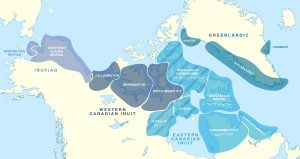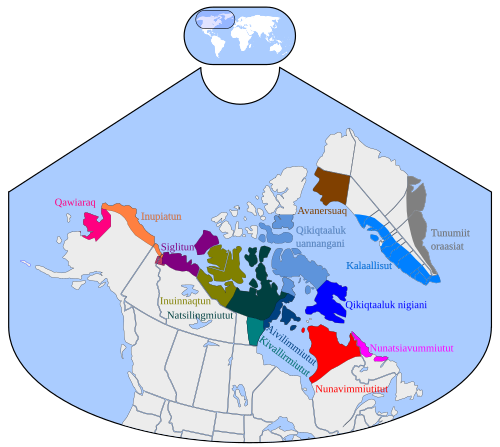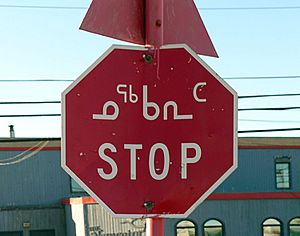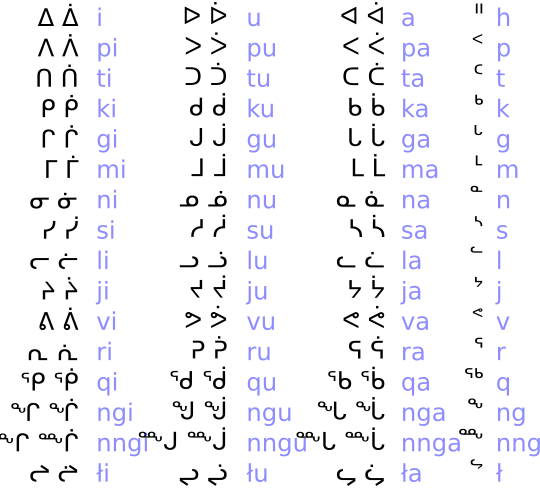Inuit languages facts for kids
Quick facts for kids Inuit |
|
|---|---|
| Ethnicity: | Inuit |
| Geographic distribution: |
Alaska, Nunavut, Northwest Territories (Inuvialuit Settlement Region), Quebec (Nunavik), Labrador (Nunatsiavut, Nunatuĸavut), Greenland |
| Linguistic classification: | Inuit-Yupik-Unangan
|
| Proto-language: | Proto-Inuit |
| Subdivisions: |
Iñupiaq (Inupiatun/Inupiat)
Inuvialuktun (Western Canadian Inuit, Kivallirmiutut, Aivilingmiutut, Qikiqtaaluk-Uannanganii)
Inuktitut (Qikiqtaaluk-Nigiani, Nunavimmiutitut, Nunatsiavummiutut)
Kalaallisut (Greenlandic)
|
 |
|
The Inuit languages are a group of closely related native languages spoken by Inuit people. These languages are traditionally used across the North American Arctic, reaching as far south as Labrador.
The Inuit people mainly live in three countries: Greenland (part of Denmark), Canada, and the United States (specifically coastal Alaska). In Canada, Inuit live in Nunavut, the Northwest Territories, the Nunavik region of Quebec, and the Nunatsiavut and Nunatuĸavut regions of Labrador.
It's hard to know exactly how many people speak Inuit languages. Many counts rely on what people report themselves. In Greenland, about 50,000 people speak different kinds of Inuit languages. In Canada, the 2016 census showed that 36,545 Inuit reported an Inuit language as their first language. About 7,500 Alaskans speak Inuit languages. Also, around 7,000 Greenlandic Inuit live in Denmark. This means nearly 100,000 people worldwide speak an Inuit language.
Contents
What are Inuit Languages Called?
The traditional language of the Inuit is actually a group of very similar dialects. These dialects are so closely related that they form a "dialect continuum." This means that people in one area can usually understand their neighbors. But if you travel far enough, the dialects become quite different, and understanding becomes difficult.
Because of this, Inuit in different places use different names for their own language and for the whole group of languages. This can sometimes be confusing!
- In Greenland, the official language is called Kalaallisut. People often call it Greenlandic in other languages.
- In Alaska, the Inuit languages are called Inupiatun. Some specific dialects are called Qawiaraq.
- In Canada, the word Inuktitut is often used for all Canadian Inuit languages. It's an official language in Nunavut and the Northwest Territories.
* Some dialects in western Nunavut and the eastern Northwest Territories are called Inuinnaqtun. * The dialects in the Northwest Territories are sometimes called Inuvialuktun. * In Quebec, the language is called Inuttitut. * In Labrador, it's called Inuttut or Labradorimiutut.
Sometimes, people outside the Inuit community use the term "Inuit language" to talk about all these different dialects together. You might also hear the term Eskimo language, but this term is not preferred in Canada and is used less often elsewhere.
How Inuit Languages Developed
Inuit languages belong to a larger language family called Eskimo-Aleut. They are closely related to the Yupik languages and more distantly to Aleut. These other languages are spoken in western Alaska and eastern Russia.
Scientists believe that early forms of the Inuit language were spoken by the Thule people. These people moved east from the Beringia area (between Alaska and Russia) into the Arctic Archipelago. By the 1300s, the Inuit and their language had reached western Greenland. They arrived in eastern Greenland around the same time the Viking settlements in southern Greenland disappeared. It's thought that during this long journey east, the Inuit language became different from the Yupik languages.
The Yupik and Inuit languages are very similar in how they are built and how words are formed. You can see their shared history in words that sound alike, called cognates:
| English | Central Yupik | Iñupiatun | North Baffin Inuktitut | Kalaallisut |
|---|---|---|---|---|
| person | yuk | iñuk | inuk (ᐃᓄᒃ) | inuk |
| frost | kaneq | kaniq | kaniq (ᑲᓂᖅ) | kaneq |
| river | kuik | kuuk | kuuk (ᑰᒃ) | kuuk |
| outside | ellami | siḷami | silami (ᓯᓚᒥ) | silami |
Where Inuit Languages are Spoken
Inuit languages are spoken across a huge area. Here's a look at where they are found:
Alaska
Out of about 13,000 Alaskan Iñupiat, around 3,000 can still speak Iñupiaq. Most of these speakers are over 40 years old. Alaskan Inupiat speak three main dialects:
- Qawiaraq: Spoken on the southern side of the Seward Peninsula. It sounds quite different from other Inuit languages.
- Inupiatun (North Slope Iñupiaq): Spoken on the Alaska North Slope.
- Malimiutun: Spoken in the Kotzebue Sound area and northwest Alaska.
Canada
Inuit languages are official in the Northwest Territories and Nunavut. They are also strongly supported in Nunavik (Quebec) and still spoken in parts of Labrador. Canadians often use the term Inuktitut for all dialects spoken in Canada.
Western Canadian Inuit
- Inuvialuktun (includes dialects like Uummarmiutun, Siglitun, Inuinnaqtun, Natsilingmiutut, Kivallirmiutut, Aivilingmiutut, Iglulingmiut)
Eastern Canadian Inuit
Greenland
Greenland has about 50,000 speakers of Inuit languages. More than 90% of them speak West Greenlandic dialects at home.
- Kalaallisut: This is the standard dialect and official language of Greenland. It's based on the language of western Greenland and has borrowed many words from Danish. It uses the Latin alphabet.
- Tunumiit oraasiat: This is the dialect of eastern Greenland. It sounds very different from other Inuit languages and has about 3,000 speakers.
- Inuktun: This dialect is spoken in northern Greenland, around Qaanaaq. It has fewer than 1,000 speakers. It's thought to be similar to the North Baffin dialect because Inuit from Baffin Island settled there long ago.
Greenlandic has always been very strong, both spoken and written. This is partly because of support from the Danish Christian mission and the creation of important dictionaries and grammar books.
How Inuit Languages Work
Inuit languages have a special way of building words. They are called "polysynthetic" languages. This means you can add many different endings (called suffixes) to a main word. These suffixes change the meaning of the word, much like adding many adjectives or phrases in English.
For example, in central Nunavut Inuktitut, the word:
- Tusaatsiarunnanngittualuujunga.
- I cannot hear very well.
This long word is made from a root word tusaa- meaning "to hear," plus five suffixes:
| -tsiaq- | "well" |
|---|---|
| -junnaq- | "be able to" |
| -nngit- | "not" |
| -tualuu- | "very much" |
| -junga | meaning "I" and showing it's happening now |
This way of building words makes them very long and often unique. It's quite different from English!
Inuit Vocabulary
Place Names and Personal Names
Inuit place names and personal names often have simple, descriptive meanings when translated. For example:
- Iqaluit means "fish" (plural).
- Igloolik (Iglulik) means "place with houses," which can mean "town."
- Inuvik means "place of people."
- Baffin Island, called Qikiqtaaluk in Inuktitut, means "big island."
Inuit also have traditional naming customs. They often use names that are simple words. For example, "Ujarak" means "rock," "Nuvuk" means "headland," and "Qajaq" means "kayak." They also use animal names like "Nanuq" (polar bear) or "Uqalik" (Arctic hare). Traditionally, Inuit believed that by taking the name of a person or thing, they could gain some of its qualities.
Disc Numbers and Project Surname
In the 1940s, the Canadian government wanted to keep track of Inuit people in the Arctic. Their traditional names were sometimes hard for non-Inuit officials to understand or pronounce. So, Inuit were given "disc numbers" on special leather ID tags, like dog tags. They had to carry these tags all the time. The numbers included a letter for the region and a number for the individual.
Later, in 1969, a program called Project Surname began. It was led by Abe Okpik. This project aimed to replace the disc numbers with family surnames, similar to how names work in many other cultures.
Words for Snow
You might have heard that Inuit have many words for snow. This is a common myth! Inuit languages actually have only a few basic words for snow. One is 'qanniq-' (or 'qanik-'), which is often used like the verb "to snow." Another is 'aput', which means "snow" as a substance.
The idea that there are many words for snow comes from how Inuit languages build words. They can add many descriptive endings to a word. So, they can easily create very long words that describe different types of snow, like "falling snow" or "snow on the ground," but these are not separate root words for snow.
Numbers
The Inuit use a counting system based on 20, not 10.
How Inuit Languages are Written
Because Inuit languages are spoken across such a large area and by different groups, there isn't just one way to write them.
Currently, there are six main ways to write Inuit languages:
- ICI Standard Syllabics (Canada)
- ICI Standard Latin script (Canada)
- Nunatsiavut Latin script (Canada)
- Inuktut Qaliujaaqpait (Canada)
- Alaskan Inupiaq script (USA)
- Greenlandic
Most Inuktitut in Nunavut and Nunavik is written using a script called Inuktitut syllabics. This system is based on Canadian Aboriginal syllabics. However, Inuit in Alaska, the Inuvialuit, Inuinnaqtun speakers, and Inuit in Greenland and Labrador use different versions of the Latin alphabet.
Greenland's Latin alphabet had a major spelling change in 1973 to match how the language was being pronounced.
Canadian Syllabics
Inuktitut syllabics, used in Canada, comes from Cree syllabics. The current form was adopted by the Inuit Cultural Institute in Canada in the 1970s.
Even though it's called "syllabics," it's not a true syllabary. It's an "abugida," which means that letters for syllables starting with the same consonant look similar.
Inuktut Qaliujaaqpait
In September 2019, the Canadian national Inuit organization, Inuit Tapiriit Kanatami, adopted a new, unified way of writing called Inuktut Qaliujaaqpait. It uses the Latin alphabet without special marks (diacritics) and is meant to be used for all varieties of Inuktitut.




